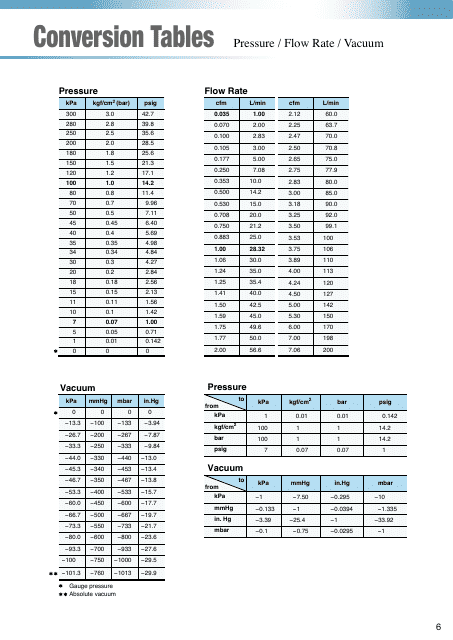Pressure / Flow Rate / Vacuum Conversion Tables
Pressure, Flow Rate, and Vacuum Conversion Tables are essential tools used in various fields, such as engineering, physics, and other technical professions. They are used to convert values from one unit of measurement to another.
-
Pressure Conversion Table is used to convert pressure units such as Pascals, Bars, Pounds per square inch (PSI), and others.
-
Flow Rate Conversion Table is utilized to convert flow rate units like liters per second, gallons per minute, cubic feet per second, and more.
-
Vacuum Conversion Table, on the other hand, is used to convert units related to vacuum pressure, such as millimeters of mercury (mmHg), torr, pascal, and others.
These conversion tables ensure accurate and consistent calculations, which are crucial in tasks including designing systems, conducting experiments, or solving problems that require these measurements. This helps to maintain standardized processes, promote safety, and ensure the efficiency of work practices in their respective fields.
Pressure/Flow Rate/Vacuum Conversion Tables are commonly used in various industries such as engineering, manufacturing, and scientific research. They are not filed by a specific country or government body. Instead, these tables are typically developed by organizations or professionals within the related industries. For instance, they might be created by a team of engineers for use in their specific projects or research, or by scientific organizations for broader sector use. Different industries may have their own set of standards for these conversion tables.
FAQ
Q: What is a pressure conversion table?
A: A pressure conversion table is a chart that allows you to convert units of pressure to other units. For example, it can help you convert from Pascals (Pa) to pounds per square inch (psi), or from atmospheres (atm) to bar.
Q: What is a flow rate conversion table?
A: A flow rate conversion table allows you to convert units of flow rate. This includes conversions between cubic meters per second (m3/s), gallons per minute (gpm), liters per second (L/s) and other units.
Q: What is a vacuum conversion table?
A: A vacuum conversion table helps you convert between different units of pressure used in vacuum systems. These might include millimeters of mercury (mm Hg), torr, pascal, or atmospheres.
Q: How can I use pressure conversion tables?
A: You can use a pressure conversion table by locating the unit you want to convert from on one axis of the table, and the unit you want to convert to on the other axis. The intersection of these two lines will give you the conversion factor.
Q: Why is flow rate conversion important?
A: Flow rate conversion is important in many fields including engineering, manufacturing, and healthcare. It allows one to apply the correct amounts of substances in processes ranging from chemical reactions to administering medication.
Q: What is a common use of vacuum conversion tables in science?
A: In science, vacuum conversion tables are often used in disciplines such as physics and chemistry, where it can be crucial to create a vacuum in certain experiments or processes. The tables make it easy to convert between different measures of vacuum pressure.


